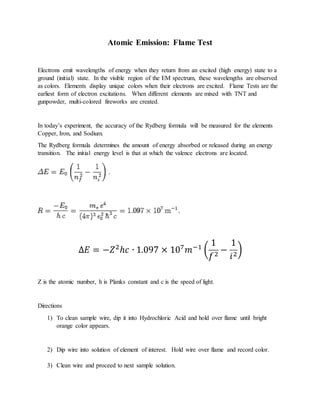Atomic Emission
•Transferir como DOCX, PDF•
0 gostou•153 visualizações
Denunciar
Compartilhar
Denunciar
Compartilhar

Recomendados
POTENTIAL ENERGY SURFACE - KINETIC ISOTOPE EFFECT - LINDEMANN THEORY - HINSHELWOOD THEORY - RRK TREATMENT- RRKM TREATMENT - SLATER'S TREATMENTPOTENTIAL ENERGY SURFACE. KINETIC ISOTOPE EFFECT AND THEORIES OF UNI MOLECULA...

POTENTIAL ENERGY SURFACE. KINETIC ISOTOPE EFFECT AND THEORIES OF UNI MOLECULA...Saiva Bhanu Kshatriya College, Aruppukottai.
Recomendados
POTENTIAL ENERGY SURFACE - KINETIC ISOTOPE EFFECT - LINDEMANN THEORY - HINSHELWOOD THEORY - RRK TREATMENT- RRKM TREATMENT - SLATER'S TREATMENTPOTENTIAL ENERGY SURFACE. KINETIC ISOTOPE EFFECT AND THEORIES OF UNI MOLECULA...

POTENTIAL ENERGY SURFACE. KINETIC ISOTOPE EFFECT AND THEORIES OF UNI MOLECULA...Saiva Bhanu Kshatriya College, Aruppukottai.
Mais conteúdo relacionado
Mais procurados
Mais procurados (19)
Spectroscopic methods uv vis transition metal complexes

Spectroscopic methods uv vis transition metal complexes
Interaction of small molecules with grapheen supported on metal substrates: A...

Interaction of small molecules with grapheen supported on metal substrates: A...
Resonant Rayleigh Scattering from Collective Molecular Excitations

Resonant Rayleigh Scattering from Collective Molecular Excitations
Semelhante a Atomic Emission
Semelhante a Atomic Emission (20)
General Chemistry I - CHEM 181Critical Thinking Exercise.docx

General Chemistry I - CHEM 181Critical Thinking Exercise.docx
Younes Sina's presentation on Nuclear reaction analysis

Younes Sina's presentation on Nuclear reaction analysis
Flame Photometry, by Dr. Umesh Kumar Sharma & Shyma M. S.

Flame Photometry, by Dr. Umesh Kumar Sharma & Shyma M. S.
Flame photometry, principle, interferences, instrumentation, applications.pptx

Flame photometry, principle, interferences, instrumentation, applications.pptx
First Year Undergraduate Inorganic Chemistry Workbook

First Year Undergraduate Inorganic Chemistry Workbook
Atomic Emission
- 1. Atomic Emission: Flame Test Electrons emit wavelengths of energy when they return from an excited (high energy) state to a ground (initial) state. In the visible region of the EM spectrum, these wavelengths are observed as colors. Elements display unique colors when their electrons are excited. Flame Tests are the earliest form of electron excitations. When different elements are mixed with TNT and gunpowder, multi-colored fireworks are created. In today’s experiment, the accuracy of the Rydberg formula will be measured for the elements Copper, Iron, and Sodium. The Rydberg formula determines the amount of energy absorbed or released during an energy transition. The initial energy level is that at which the valence electrons are located. ∆𝐸 = −𝑍2 ℎ𝑐 ∙ 1.097 × 107 𝑚−1 ( 1 𝑓2 − 1 𝑖2 ) Z is the atomic number, h is Planks constant and c is the speed of light. Directions 1) To clean sample wire, dip it into Hydrochloric Acid and hold over flame until bright orange color appears. 2) Dip wire into solution of element of interest. Hold wire over flame and record color. 3) Clean wire and proceed to next sample solution.
- 2. Calculations 1) Match color with wavelength on following website: http://www.wolframalpha.com/widgets/view.jsp?id=628bfed9ce559d754c3eabcfca44366 b 2) Use formula c=λν to solve for the frequency of the color observed. 3) Use formula E=hν to find the energy of the wavelength. 4) Use the Rydberg formula to solve for the excited energy level of an electron from an element. Element Color Wavelength Frequency Energy Excited Energy Level Sodium Calcium Nickel 5) Was it possible to find the excited energy level for all of the elements tested? If not, Why didn’t the Rydberg formula work? Laboratory Report Format Introduction: State Objective and Chemical Reaction involved. Define Stoichiometry Procedure: List steps taken and data collected. Conclusion: Did experiment work?